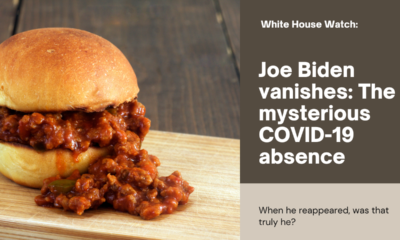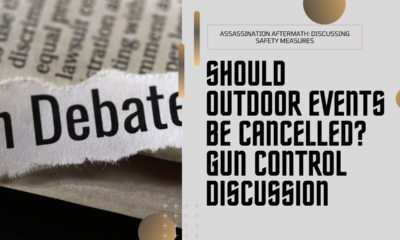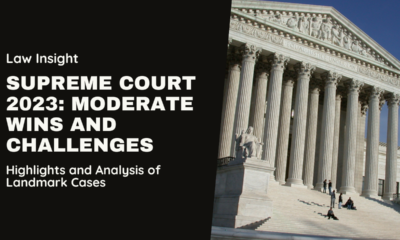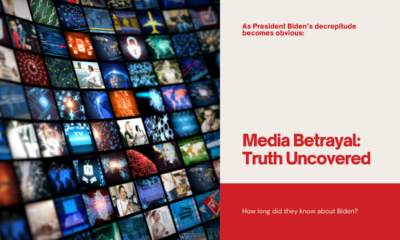Executive
Homeland Security Cited Inaccurate Allegation to Censor New York Times Journalist
The Department of Homeland Security targeted Reid J. Epstein of The New York Times – and his bosses did little to push back.

By Lee Fang, RealClearInvestigations
and LeeFang.com
February 5, 2024
As the 2020 Election Day count dragged on into the next morning in the crucial swing state of Wisconsin, the New York Times campaign reporter Reid Epstein reported a hiccup at 4:52 a.m.: “Green Bay’s absentee ballot results are being delayed because one of the vote-counting machines ran out of ink and an elections official had to return to City Hall to get more.”
Eight minutes later Epstein sent a follow-up tweet giving the all-clear: “Clerk has returned with printer ink!”
This tiny drama from Wednesday, Nov. 4, would be lost to history but for the deep consternation it ignited among influential members of the government and tech industry. Details uncovered in the Twitter Files and revealed here for the first time show that Epstein’s tweet prompted immediate and mostly successful speech suppression efforts by the Department of Homeland Security and others who were intent on undermining any facts or claims that might possibly be used to question the integrity of the 2020 election.
The episode is of more than passing historical note because it is the first known case of the agency attempting to silence a social media account associated with a national newspaper – and because the Times, which has long professed to report the news “without fear or favor,” did little to push back against the censorship, even though nothing has emerged to invalidate Epstein’s reporting.
Epstein’s tweet set off immediate alarm bells in Wisconsin and Washington, D.C. At 5:11 a.m., 19 minutes after Epstein’s first tweet, an election clerk from another part of the state, Rachel Rodriguez, disputed the Times’ reporting on Twitter: “I’m very familiar with the ballot scanners Green Bay uses,” wrote Rodriguez. “There’s no ink involved.”
Four minutes later, at 5:15 a.m., the official Twitter account of the Wisconsin Elections Commission retweeted Rodriguez’s post commenting, “Rachel is correct.”
Except she was not. Although most of Green Bay’s voting machines did not use ink – the DS200, the primary vote-counting machine, relied on thermal tape – that year, there was another machine involved. Local officials, in expectation of higher turnout for the heated presidential race and newly eased rules concerning absentee ballots, opted to additionally use the DS450, a high-speed tabulator that prints results through an external ink-jet printer.
Rodriguez recently told RCI that her 2020 tweet was based on the mistaken understanding that Green Bay used only DS200 machines for the election. She also confirmed that if the city had indeed used a high-speed tabulator, like the DS450 or its variation, the DS850, then her tweet would have been mistaken, because that system uses ink cartridges through an external printer. She explained over phone that her tweet fact-checking Epstein got “way more traction than I thought.” Rodriguez added that “it was 3 a.m. and I was just being sarcastic.”
Her tweet did, indeed, set off a chain reaction at the highest levels..
“This is false,” Amy Cohen, the executive director of the National Association of State Election Directors wrote at 7:45 a.m. on the morning of Nov. 4, linking Epstein’s tweet. “There is no ink involved in the machines used in tabulation of the ballots, a fact confirmed by the state.” Cohen’s email was addressed to the election consortium organized by the Center for Internet Security (CIS), a contractor tasked with facilitating misinformation reports from a variety of stakeholders to DHS and private social media firms.
CIS quickly elevated the tweet in a “Misinformation Report” sent to officials at the Cybersecurity and Infrastructure Security Agency (CISA), the DHS sub-agency with a focus on policing social media. Brian Scully, a DHS official with CISA who then led a task force on “countering foreign influence,” attached a screenshot of the Epstein tweet and sent it to Twitter along with a note that claimed the “tweet alleges tabulation machine ran out of ink which caused delay in counting absentee ballots – there is no ink involved in tabulation machine (Green Bay, WI).”
Stacia Cardille, then a senior Twitter legal executive, thanked Scully for the alert and told the DHS official, “We will escalate.” She then forwarded the email on to a team devoted to “site integrity.” “Hi GETSupport, can you please review this report from the National Association of State Elections Directors by way of DHS?” wrote Cardille in an email time-stamped 8:30 a.m. “Please note the rebuttal information from the official handle of the state election director.”
By 9:27 that morning, Cardille wrote to inform Scully that the social media platform had “labeled this Tweet.” Scully emailed back to convey his appreciation.
The “label” action appears to refer to what’s known as a shadow ban. After receiving significant attention, the Epstein tweet disappeared for most users. The tweet became invisible for those who had quote-tweeted it and users could no longer reply to it. The public metrics of the tweet, with over 1,000 retweets and 3,180 ‘likes,’ as well as all reply tweets, vanished. Any user attempting to view the Times reporter’s tweet via direct link was greeted by a warning label that it might contain misinformation.
Adding to the uncertainty around the issue, the Green Bay Press Gazette, the local newspaper, also criticized Epstein’s tweet as inaccurate. Sandy Juno, who oversaw the 2020 election ballot count as the Brown County Clerk, told RealClearInvestigations that she may have also contributed to the misunderstanding about the voting machine issue and printer ink.
“I got a call from the media about the ink situation,” said Juno. “I said, ‘What do you mean, these machines don’t use ink?’“ But she misunderstood that the questions revolved around the count at the convention center using DS450 tabulators, not the sites using DS200 machines.
“So I might have started the confusion,” added Juno. The former clerk, who has since resigned and openly criticized Green Bay over its management of the election that year, said she is confident that the ballot certification numbers were correct. Juno confirmed that the high-speed tabulation machines, like the DS850 and DS450, use an attached ink-jet printer. Juno also noted that the KI Convention Center vote-counting site had photocopiers, which also use an ink cartridge, another possible explanation for the ink cartridge issue.
Questions swirling around the integrity of the 2020 Wisconsin vote have led to official court challenges and probes by Republicans. Those investigations, while failing to overturn the result, further confirmed the likely accuracy of the Epstein tweet.
Simple Explanation Dismissed
Observers note that neither the state commission nor CIS disputed or even addressed the root issue – the pause in vote counting – but refocused the discussion on the reason why it had occurred. The effort to dismiss the simple explanation – the printer ran out of ink – may have increased skepticism about the results.
Wisconsin local officials whom RCI contacted for this story said they remembered questions concerning why one election official left and returned to the KI Convention Center during the count and recalled rumors that an official was seen carrying a thumb drive that could have been used to tamper with the results. But the probe revealed that the clerk was carrying an ink cartridge. It seems likely that the cartridge was the same one referenced by Epstein.
In response to concerns around the election process that year, the city of Green Bay commissioned a study. The report, overseen by city attorney Vanessa Chavez, confirmed the use of a DS450 high-speed vote tabulation machine at the offsite WI Convention Center, a few blocks away from city hall.
NASED, the election official group that reported the Epstein tweet to the DHS consortium, did not respond to a request for comment.
The New York Times also did not respond to repeated requests for comment. Epstein declined to comment, as well – even though he could help resolve the matter by identifying the source for his tweet. The Times has not corrected the tweet and, notably, referenced the Green Bay ink delay issue in a Nov. 6 article. Nevertheless, neither Epstein nor the Times appear to have pushed back against the shadow-ban on the tweet. Even today, the message is still throttled and carries the warning label: “Some or all of the content shared in this Post is disputed and might be misleading about an election or other civic process.”
Adam Candeub, professor of law at Michigan State University and an expert on free speech issues, said he could not comment specifically on decisions made by the New York Times, but noted there has been a sea change among major organizations on speech issues.
“Institutions with a left of center, left-wing perspective have usually been associated with free speech,” said Caneub. “The most important First Amendment case is New York Times v. Sullivan. But one has to get the feeling that institutions that traditionally have been pro-free speech have retreated from that,” he said. “There could be political or cultural reasons.”
“Journalists and media organizations should be deeply concerned about the government using backchannels to pressure social media companies to censor reporting, especially given that half of Americans get their news on social media,” said Aaron Terr, director of public advocacy at the Foundation for Individual Rights and Free Expression.
CISA released a statement noting that its misinformation reports relied upon “state and local election officials and other election infrastructure stakeholders.” CISA, through a spokesperson, declined to address the accuracy of the Epstein tweet or the allegation that led to the suppression. The spokesperson noted that the agency would not continue the misinformation reporting program for the 2024 presidential election.
The agency declined to take responsibility for the censorship of the Times journalist. “Social media companies, as always, made their own decisions regarding the content on their platforms,” the spokesman said in an email.
Whether the agency intended to pressure Twitter to censor the tweet is open to interpretation. The email chain obtained by RCI and other documents from the Twitter Files and recent congressional investigations strongly suggest that CISA sought action on the Epstein tweet, as it had sought action on other instances of alleged misinformation.
The backend system used by the Election Integrity Project, CISA’s stakeholder partner for its 2020 program to report misinformation, gave explicit censorship demands, according to records released by the House Judiciary Committee last year. “We recommend you label or reduce the discoverability of the post,” noted one EIP request. Other tickets similarly asked that Facebook, Twitter, and Reddit “remove” social media posts and “suspend” certain users.
Often, tweets singled out by watchdog groups as misinformation contained lawful speech that was either accurate or areas of intense scientific debate with no clear answer. The Virality Project, a successor group to the EIP, flagged a tweet from Rep. Tom Massie, R-Ky., that cited research showing that natural immunity provided the same effectiveness as the Pfizer vaccine. Another tweet from Massie flagged by the Virality Project was a message that the vaccine is likely to harm young children more than the COVID-19 “virus is likely to harm young children,” a claim that has been largely substantiated by government research.
Government encroachment on the free press and on social media has raised increasing concerns for civil liberty groups.
“The government should never ask platforms to remove journalists’ truthful reporting,” said Seth Stern, director of advocacy the Freedom of the Press Foundation. “If the government is going to be in the business of flagging misinformation for social media platforms it has an obligation to do its homework and make sure it gets it right.”
“Government officials leaning on social media platforms to suppress so-called misinformation is dangerous because it inevitably denies Americans access to truthful information,” noted Terr. “The government itself often gets things wrong or makes politically motivated decisions about what speech to purge from public discourse.”
The history of the development of CISA as a misinformation-fighting government agency, with sprawling influence within multiple social media platforms, is detailed in investigative reporting I published in October 2022. The story revealed whistleblower documents that show the agency had planned to widen its reach to counter “the origins of the COVID-19 pandemic and the efficacy of COVID-19 vaccines, racial justice, U.S. withdrawal from Afghanistan, and the nature of U.S. support to Ukraine.”
Many of the censorship plans were intentionally concealed through third parties. Documents released by court order showed that Geoff Hale, the director of the Election Security Initiative at CISA, said that the agency should use nonprofit groups as a “clearing house for information to avoid the appearance of government propaganda.”
The legality of such measures is now under Supreme Court review. The court is scheduled to hear oral arguments in Missouri v. Biden, retitled Murthy v. Missouri, which challenges the constitutionality of government social media interventions as a form of censorship, beginning next month.
This article was originally published by RealClearInvestigations & LeeFang.com and made available via RealClearWire.
Lee Fang is an investigative journalist and Contributing Editor at UnHerd.
-

 Executive4 days ago
Executive4 days agoSecret Service chief gets no solace
-

 Executive3 days ago
Executive3 days agoWaste of the Day: Louisville Taxpayers Pay Nearly $600,000 For Empty Building’s Maintenance, Security
-

 Guest Columns4 days ago
Guest Columns4 days agoFear Itself: Democrats’ Favorite Strategy Caused Their Current Chaos
-

 Executive3 days ago
Executive3 days agoWhere is Joe Biden – or Jill?
-

 Executive1 day ago
Executive1 day agoWaste of the Day: Throwback Thursday: Cities Used Crime Prevention Funds on Soccer Games, Paper Shredding
-

 Executive2 days ago
Executive2 days agoFacile and politically motivated suggestions
-

 Civilization5 days ago
Civilization5 days agoBuild Iron Dome in the United States To Prepare for Israel’s Worst Day
-

 Executive4 days ago
Executive4 days agoThe Emerging GOP Plan To Beat Kamala Harris














